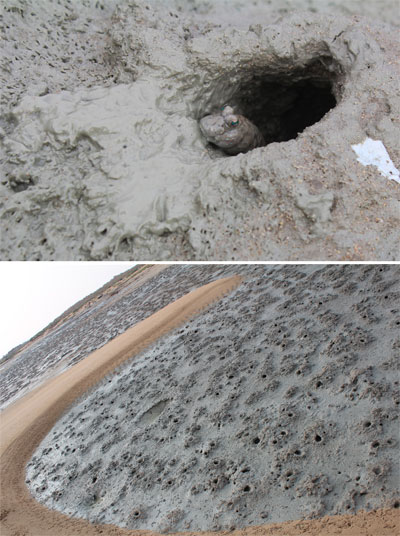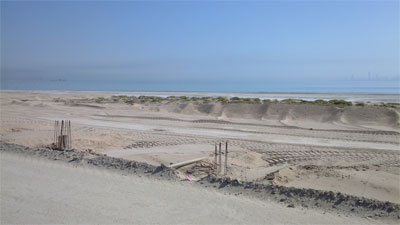
In 2011, there was a meeting held between the Kuwait Society for the Protection of Animals and Their Habitat (K’S PATH) and en.v, a Kuwaiti social responsibility organization. The purpose of that meeting was to discuss how, with limited sponsorship and very limited government support, the two organizations could work together to provide real, tangible, and lasting protection for some of the last remaining coastal habitat areas in Kuwait Bay. The result, after much discussion, was the joint venture Al Yaal, whose mission would be to conduct hands-on conservation in three coastal habitats, document those efforts, and educate the population of Kuwait about the needs of our fragile environment. From the beginning, we didn’t know if the program would work. There was no way to predict whether or not our work would be enough to improve the environment we set out to protect, nor whether or not we would be able to engage the community to conserve coastal areas they had never seen before and had no vested interest in. The program was destined from the beginning to be a small, grass-roots effort to protect something we all knew would vanish if no one fought for it. The results would be surprising in more ways than one.

K’S PATH has been around now for about ten years, providing animal sheltering, education, lobbying, habitat protection, consultancy, and more. People who interact with us for the first time are often surprised that an organization like ours exists, not just because we help animals, but even more so because we are so professional in the way we work. Their surprise is understandable, because in general, we don’t make a lot of noise. We are able to do all of the things we do, and do them well, because we invest most of our time and effort into our programs and have very little left over for publicity. We brought this same focus and dedication to the Al Yaal program. There are many organizations that clean beaches in Kuwait, and they all deserve commendation for doing so. What most of them have in common is that they clean beaches humans use for recreation. With our animal and environment-centric focus, we wanted to protect areas that are important coastal habitat, so we started doing some research to see what areas were the most at risk of pollution and encroachment. Through a process of interviews and observation, we selected three beach areas notable for their plant life, their bird life, their animal life, their lack of development, lack of human visitation, and heavy pollution. Two sites were chosen in Sulaibikhat area, and one in the Doha area.
K’S PATH has always operated with a simple philosophy: planning and hard work equals results. Planning for this program included hiring program manager Angelique Bhattacharjie-Jeremiah, purchasing equipment, organizing volunteers, getting ministry permits, and coordinating between the different organizations involved. By April of 2011, planning was complete and the hard work began. Cleaning a beach with the idea of habitat preservation in mind is a meticulous job. Heavy equipment and teams of laborers play no part in removing waste from a sensitive habitat. Each item of waste has to be carefully removed by hand without destroying or even damaging plants or animal dens. The pace is slow, the temperature grueling, and success comes at a snails pace. Despite dozens of bags of garbage collected, it’s difficult to notice any improvement after the first few cleanups. Still, the volunteers kept coming.

The Al Yaal concept doesn’t rely upon a single body or group of volunteers. Instead, a different social group, school, or society is involved in each clean up, thereby maximizing the number of people who participate in this important project. After all, participation is an incredibly effective form of education, and engaging so many different people from so many different walks of life helped tremendously in breaking up the tedium of our efforts. K’S PATH staff and dedicated program volunteers in particular deserve a very hearty thank you for their consistent hard work (they were present at nearly every clean up for two years), but even after the first dozen clean ups, nothing much seemed to change. Sans instant gratification, we just kept working. And working. And working. All told, we came back 45 times and cleaned up over 5 tons of waste at Doha beach alone. The task was arduous, but rewarding.
What makes picking up garbage rewarding? On paper, we knew it was important to protect our coastline before we ever started this project, and reality in the field was a delightful confirmation of this foreknowledge. Program participants had the good fortune of seeing a wide range of Kuwaiti and regional wildlife including a host of migratory birds, a large number of local birds (including cormorant), spiny tailed lizards, kangaroo mice, mudskippers, crabs, Ruppells fox, and a variety of beetles and other insects. In short, we had chosen a perfect stretch of coastline to protect; the ecosystem was complete and functioning. It just needed a little help, and the Al Yaal team was there, week after week, month after month, helping the coastal ecosystem do what it was intended to do: provide a habitat for the organisms that play a pivotal role in cleaning coastal waters and nursing our fisheries.

It took nearly two years of effort, but at long last, Doha beach was in such good shape that it only needed a little maintenance to remove any new waste. So in late September 2013, our team arrived to prepare for yet another routine clean up. The sight that awaited them, however, was the stuff of environmental nightmares. The entire habitat that had been so carefully and meticulously maintained for two years was gone. Simply vanished. The entire area had been bulldozed in order to build a chalet. The trees used as nesting sites for birds: gone. The dens used by fox, reptiles, and rodents: gone. Nothing now remains but a narrow strip of green along the waters’ edge, hardly enough for the tidal species to survive. All of our passions, sweat, toil and tears were obliterated in a single day.

The question we are all asking ourselves now is what’s the point? Al Yaal can, and likely will, continue to protect the remaining beaches we’ve identified as being in the greatest need. In fact, at K’S PATH, we consider it our jobs to make Kuwait a better place, but are we wasting our time? If developers can bulldoze one of Kuwait’s last precious coastal ecosystems, if our fragile islands receive no protection at all, and if poaching continues at its current alarming rate, do nature and wildlife in Kuwait really stand any chance at all? And are we as a nation willing to trade every scrap of habitat for concrete and pasture land? The answers to those questions won’t matter soon; it will simply be our reality if we don’t take rapid and drastic action. There are many good people in Kuwait who want to see a truly healthy environment, and it will take all of us working together to make change happen. K’S PATH needs you, Al Yaal needs you, and most importantly, Kuwait needs you. The time is now. Visit www.kspath.org, Facebook: K’S PATH and Al Yaal, Call 6700-1622 or email [email protected] to find out how you can help.
You can also email the author, K’S PATH Managing Director John Peaveler via [email protected]
Post by John Peaveler
Managing Director
Kuwait Society for the Protection of Animals and Their Habitat (K’S PATH)

5 replies on “Our Natural Heritage is Vanishing”
Thanks mark! your more aware than most of kuwaitis living here.
is that a stray dog in the second photo ?
sad
When was the last time anyone saw a wolf in Kuwait. Then you get morons who spot one.
https://www.alanba.com.kw/ar/last/358056/02-02-2013
It was in the newspapers and what protection was done. I mean EVERYONE who reads the newspaper knew about it, even the officials.
Government officials and MPs.
Now lets talk about lesser know habitats which near no one knows about let alone care about … Its the dumb reality we have.
Oh by the way, do we know what happened t the gazelles in Sabah Al Ahmad “Nature Reserve” !!!!!!!
“And are we as a nation willing to trade every scrap of habitat for concrete and pasture land?”
Yes. And every scrap of natural resources for self gratification and instant enjoyment. You should have realized this by now. Even most of the environmentalist wannabes in this blog own illegally built chalets or know friends who have them, and they won’t mind spending the upcoming pleasant weekends in them.